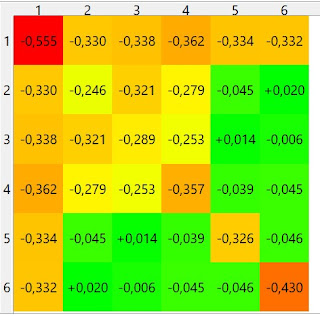Okay, dear readers, I'm sick at home with an awful cold (plain normal cold, nothing covidish) and have time to play and analyze a few Backgammon games. Here's another position that stunned me:
I'm white and have to play 61. The move 8/2, 3/2 looked straightforward to me: it extends my board to 5, it doesn't endanger my back men - the men on 19-17 seem to threaten building a bad board, fast, if they get a blot to hit, and it only leaves a single blot 1 away from 7.
XG doesn't like this move at all. In fact it believes that the best move keeps the game equal, while mine brings it down to -0.28, so I lose a third of a (1 point) game with this move.
And the move it suggests is... 22/16, 3/2. WHAT?
Let's look at the dice distribution for my opponent after the two rolls:
The first image shows my winning chances for each roll that the opponent can do for the XG move, the second one does the same for my move. Example: first image, column/row 3/4 shows +0.082. This means that after XG's move if the opponent rolls 34, the outcome will be a 0.082 in my favor.
A few interesting observations: other than I thought, only 33, 44, 55, 66 are rolls I have to fear when playing the XG move. Moves like 43 that I was fearing are probably not so bad, because black will only have a 3-point board and a blot that I might hit as well. 31, 41, 54 that I also feared (hitting me and moving on to cover its own blot are still not too bad for me for the same reason - a 3-point board isn't too bad.
On the other side, the same doubles 33, 44, 55, 66 are similarly bad in my move. After all, my two men are trapped behind black's little prime; if black moves his trailing men safely forward with the double, he can wait for my men to pass the prime.
My lesson for the day: if confronted with an intimidating prime, look whether things are really as bad as you think.






No comments:
Post a Comment